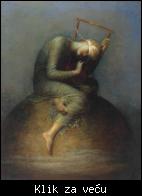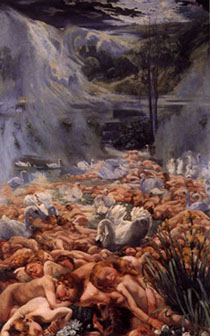|
Poslao: 19 Jan 2010 15:14
|
offline
- Pridružio: 25 Avg 2008
- Poruke: 740
- Gde živiš: na bezbednom rastojanju od pojedinih
|
jelkica7 ::Valjda sam potrefila množinu od bufalo, 7:45 je mnogo rano za mene. 
Džordž Ketlin (George Catlin), Lov na bufale pod kožom belog vuka, ili tako nekako.
[Link mogu videti samo ulogovani korisnici]
[Link mogu videti samo ulogovani korisnici]
Tako je ,Jelkice... 
Naslov mislim da je ''Lovci na bufala maskirani vucjim krznom na dnu litica''...
Izvoli... 
|
|
|
|
|
Registruj se da bi učestvovao u diskusiji. Registrovanim korisnicima se NE prikazuju reklame unutar poruka.
|
|
|
Poslao: 19 Jan 2010 16:40
|
offline

- Pridružio: 07 Avg 2008
- Poruke: 2528
- Gde živiš: VII kat
|
Hvala danka.
 
Viktorijanski umetnik, poznat po alegorijskim delima.
Želja mu je bila da načini epski ciklus slika, u kom bi putem univerzalnog jezika simbola prikazao ljudske emocije i čežnje.
|
|
|
|
|
|
|
Poslao: 19 Jan 2010 17:20
|
offline
- Pridružio: 25 Avg 2008
- Poruke: 740
- Gde živiš: na bezbednom rastojanju od pojedinih
|
George Frederic Watts,...Dzordz Federik Wotc...Engleski slikar,vajar...
a,ovo delo nosi naziv NADA..Inace,omiljena slika Baraka Obame...
George Frederic Watts, OM (23 February 1817 – 1 July 1904; sometimes spelled "George Frederick Watts") was a popular English Victorian painter and sculptor associated with the Symbolist movement. Watts became famous in his lifetime for his allegorical works, such as Hope (see image) and Love and Life. These paintings were intended to form part of an epic symbolic cycle called the "House of Life", in which the emotions and aspirations of life would all be represented in a universal symbolic language.
[Link mogu videti samo ulogovani korisnici]
It is Barack Obama's favourite painting: this famous canvas by the visionary Victorian artist George Frederic Watts arguably set the President-Elect on his long path to the White House.
[Link mogu videti samo ulogovani korisnici]
[Link mogu videti samo ulogovani korisnici]
|
|
|
|
|
|
|
Poslao: 19 Jan 2010 17:37
|
offline

- Pridružio: 07 Avg 2008
- Poruke: 2528
- Gde živiš: VII kat
|
danka- ::a,ovo delo nosi naziv NADA..Inace,omiljena slika Baraka Obame...
Da, vidim.  Našla sam sada i ovo: Našla sam sada i ovo:
"Alison Smith, curator at the Tate Britain museum, says that a reproduction of "Hope" was also in Nelson Mandela's prison cell."
Read more: [Link mogu videti samo ulogovani korisnici]
Citat:Perhaps the answer lies in the fact that it is not, in essence, a traditionally Christian image. This hunched, isolated, blindfolded and barefoot woman seems, despite the title, to be on the edge of despair. This is not the “sure and certain hope” of Christian tradition. It is more like the hope implied by the expression “hoping against hope”. It is the hope of those who refuse to submit to despair when it beckons.
This is probably why the painting seemed so persuasive to Watts’s Victorian contemporaries. As the art historian Malcolm Warner has pointed out, in an age beset by religious doubts, the work appeared to visualise Tennyson’s dubious expression of faith from In Memoriam: “To faintly trust the larger hope.” The trust expressed by the figure is certainly faint. Only one string on her crude wooden lyre remains unbroken. It is her only hope of music, but seems as likely to snap as to sound. In other words, she remains entranced by beauty even when it seems so tenuous.
[Link mogu videti samo ulogovani korisnici]
Tačno danka, može dalje.
|
|
|
|
|
|
|
Poslao: 19 Jan 2010 19:46
|
offline
- Pridružio: 25 Avg 2008
- Poruke: 740
- Gde živiš: na bezbednom rastojanju od pojedinih
|
Napisano: 19 Jan 2010 19:45
 ... ...

Belgijski umetnik...
|
|
|
|
|
|
|
Poslao: 19 Jan 2010 20:49
|
offline

- Pridružio: 07 Avg 2008
- Poruke: 2528
- Gde živiš: VII kat
|
Léon Fréderic, L'eau - l'eau dormante, deo triptiha Le ruisseau ili l'Eau (?) 1890-99.
[Link mogu videti samo ulogovani korisnici]
[Link mogu videti samo ulogovani korisnici]
[Link mogu videti samo ulogovani korisnici]
|
|
|
|
|
|
|
Poslao: 19 Jan 2010 21:21
|
offline
- Pridružio: 25 Avg 2008
- Poruke: 740
- Gde živiš: na bezbednom rastojanju od pojedinih
|
BRavo Jelkice...  .. ..
Izvoli... 
|
|
|
|
|
|
|
|
|
Poslao: 20 Jan 2010 06:36
|
offline
- tuzor

- Legendarni građanin

- Pridružio: 03 Sep 2007
- Poruke: 4115
- Gde živiš: U Kraljevstvu duha
|
Stari majstor je Francisko Goja (maločas mi pade na pamet, što svedoči da je jutro pametnije od večeri  ), njegova serija grafika nosi naziv "Nesreće/katastrofe/užasi rata" (The Disasters of War); savremeni "dorađivači" su braća Džejk i Dino Čapman. Naziv grafike iz pitanja je u originalu "No se convienen" (They do not agree), ), njegova serija grafika nosi naziv "Nesreće/katastrofe/užasi rata" (The Disasters of War); savremeni "dorađivači" su braća Džejk i Dino Čapman. Naziv grafike iz pitanja je u originalu "No se convienen" (They do not agree),
Citat:They began their own collaboration in 1992. The brothers have often made pieces with plastic models or fibreglass mannequins of people. An early piece consisted of eighty-three scenes of torture and disfigurement similar to those recorded by Francisco Goya in his series of etchings, The Disasters of War (a work they later returned to) rendered into small three-dimensional plastic models. One of these was later turned into a life-size work, Great Deeds Against the Dead, shown along with Zygotic Acceleration, Biogenetic, De-Sublimated Libidinal Model (Enlarged x 1000) at the Sensation exhibition in 1997.
[Link mogu videti samo ulogovani korisnici]
Citat:The Disasters of War (Spanish: Los Desastres de la Guerra) is a series of 82[1] prints created between 1810 and 1820 by Spanish master painter and printmaker Francisco Goya (1746–1828-). The name by which the series is known today is not Goya's own. His handwritten title on an album of proofs given to a friend reads: Fatal consequences of Spain's bloody war with Bonaparte, and other emphatic caprices (Fatales consequencias de la sangrienta guerra en España con Buonaparte, Y otros caprichos enfáticos).[2] Aside from the titles or captions given to each print, these are Goya's only known words on the series. With The Disasters of War, Goya breaks from a number of painterly traditions. He rejects the bombastic heroics of most previous Spanish war art to show the effect of conflict on individuals. In addition he abandons colour and line in favour of a more direct truth he found in shadow and shade.
. . .
In 1993, Brit artists Jake and Dinos Chapman created 82 miniature, toy-like sculptures modelled on The Disasters of War. The works were widely acclaimed and were purchased that year by the Tate gallery. In 2003, the Chapman brothers exhibited an altered version of The Disasters of War. They purchased a complete set of prints, over which they drew and pasted demonic clown and puppy heads. The Chapmans described their "rectified" images as making a connection between Napoleon's supposed introduction of Enlightenment ideals to early 19th-century Spain and Tony Blair and George W. Bush purporting to bring democracy to Iraq. In The Guardian, Jonathan Jones wrote, "When I see the images, I think they are brilliant and profound. Oh dear. Somehow, they do not destroy, but find something new in the Disasters of War."
[Link mogu videti samo ulogovani korisnici]
[Link mogu videti samo ulogovani korisnici]
Dela braće Čapman imaju zajedničko ime "Uvreda/skrnavljenje povrede", a možda i "Pozleđivanje rane" (Insult to Injury).
Citat:"We had it sitting around for a couple of years, every so often taking it out and having a look at it," says Dinos, until they were quite sure what they wanted to do. "We always had the intention of rectifying it, to take that nice word from The Shining, when the butler's trying to encourage Jack Nicholson to kill his family - to rectify the situation," interrupts Jake.
"So we've gone very systematically through the entire 80 etchings," continues Dinos, "and changed all the visible victims' heads to clowns' heads and puppies' heads."
The "new" work is called Insult to Injury. The exhibition in which it will be shown for the first time, at Modern Art Oxford, is called The Rape of Creativity.
[Link mogu videti samo ulogovani korisnici]
[Link mogu videti samo ulogovani korisnici]
|
|
|
|
|
|
|
Poslao: 20 Jan 2010 12:40
|
offline

- Pridružio: 07 Avg 2008
- Poruke: 2528
- Gde živiš: VII kat
|
Sve navedeno, sve tačno, tuzor - izvoli. 
|
|
|
|
|
|




















